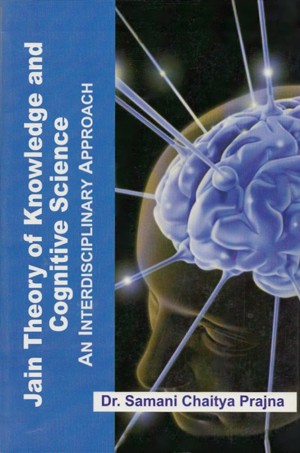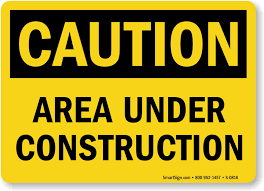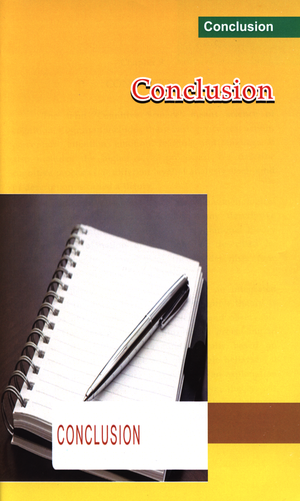
The term 'Cognitive Science' means science of cognition. Cognition includes these basic processes: action, perception, attention, emotion, learning and language. It also 'includes the higher level processes. We describe cognitive processes at different level of analysis. Each kind of description is called a theory.
A descriptive theory describes phenomenological experience and observable behavior. Many descriptive theories are quantitative models. A computational theory provides an explanation of the behavior described by descriptive theory. Neurological theory describes how brain's behavior produces computations.
Jain theory of knowledge is rather an integrated theory of all the above theories. It is descriptive theory as it describes phenomenological experience and observable behavior. The classification of information processing in the forms of intelligence are fundamentally based on phenomenological experience and observable behavior, it is also computational theory as it provides an explanation of the behavior described by descriptive theory. As neurological theory describes how brain's behavior produces changes the Jain theory of knowledge based on karma, which can be regarded as the basis of neuroscience.
The basis of all cognitive acts is neuro-science. Neuroscience is an important discipline in cognitive science. As far as Jain view is concerned, the basis of all cognitive acts is karma. In fact, it can be said that even all neurological acts are based on the science of karma. Thus both the fields - neuro-science and karma-science, the former accepted by the Science and later by Jainism, are intricately related with each other and equally responsible for cognition to occur. This is very well established by Prabha Jain and L.C. Jain.[1] These states of action potential and resting potential can be compared with dormant and rising states karma. In fact function of nervous system can be explained on the basis of partial destruction and rise of karmic particles.
As far as information processing is concerned, depending on the kind of data, the processing can be three types:
- Processing of Sensory or perceptual Information
- Processing of Expression
- Processing of Extra Sensory Information
Jain theory of knowledge, has covered the processing of sensory or perceptual information as the function of mati jñāna (perceptual knowledge) and the processing of expression under the function of śruta jñāna (verbal knowledge). Processing of extra sensory information is the function of Pratyakṣa jñāna (Direct cognition) such as Avadhi jñāna (Clairvoyance), Manahparyava jñāna (mind reading) and Kevalajñāna (Omniscience).
According Jain texts, knowledge is the inherent nature of the soul. Each kind of knowledge has its own importance; it is manifested in different degrees depending on subsidence and destruction of karmic veils. When these veils are totally removed, infinite knowledge of soul manifests itself in the form of pure and perfect knowledge i.e. all the imperfectness, incompleteness of knowledge dissolves with the rise of omniscience.
At primary level, cognition is based on neurological functions of brain and neurological development is based on karmic destruction cum subsidence but omniscience which occurs directly through soul, it does not need the assistance of sensory and neurological functions.
Sense organs play an important role in the neurological functions. They act as windows to external world in the empirical and perceptual cognition but for those whose part or full body, when uncovered, becomes a medium of cognition, there is no need any help of these sensory windows. This category of cognition falls under extra- sensory or immediate perception. Thus, the five varieties of knowledge are divided into the two classes of approved types of knowledge-the mediate and immediate.
The division of knowledge into two classes is an innovation of Jain philosopher. In the established Indian tradition, the approved means of knowledge were most often divided into four classes: perception, inference, analogy and articulation/scripture. Umāsvāti follows the ancient Jain tradition of the five varieties of knowledge and the innovative allocation of these as mediate or immediate knowledge.
Jain theory of knowledge gives detailed but fragmented information about senses. It not only deals with' the classification of senses but also their shapes, acquisition, capacities too.
Once the data is acquired through the sense organs, the input process is complete and then the processing takes place as follows:
Fig No. 9.1. Jain Model of Information Processing
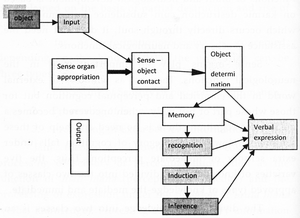
Jain epistemology deals in detail with all the steps the perceptual cognition. The exact process of information processing is divided into multi steps, which is one of the most unique characteristics of Jains view of cognition, the process start with sense object contact as a sensory input similar to that of sensory registration in neuro-biology. Indriya sannikarṣa in other Indian philosophy and passes through various stages such as avagraha (sensation), īhā (speculation), avāya (perceptual Judgement), dhāraṇā (retention), smṛti (memory), Pratyabhijñā (recognition), tarka (inductive reasoning) and Anumāna (inference/ The output is in the form of verbal expression. In fact, each antecedent acts as the input for the consequent stages which is the output of the antecedent.
Sensory input is attained only when there is a contact between the object and senses. But prior to this sense-organ-appropriation stage, discuss in detail each of five senses, their shapes - external and internal structure and their functions. In Jain canons such as Nandi and Viśeṣāvaśyaka Bhāṣya. The number of the senses remains the same in both scientific and Jain tradition. The classifications of sense organs in physical and psychical types are exclusively unique and scientific. However, the contact ability is common in both the traditions.
Once the senses are equipped to cognize the object there occurs the first stage called avagraha similar to that sensory registration stage of cognitive psychology, where there occurs a real contact between the object and sense. This leads to input of the sensory data.
The next stage to the sensory registration is feature analysis stage. This stage in Jainism is known as Ihā (speculation) where the mind processes the data acquired as pvq, -p/q. According to western logic any decision that takes place in this process is logically called as Modus Tollens. Mind speculates over what is registered through senses and eliminates the inappropriate information. This stage is explained in cognitive biology as feature analysis stage.
In the third stage, the object is determined as perceptual judgment which according to Arnold is the stage of object construction and judgment. This stage has two classes of judgment as has been described earlier they are categorization judgment and contextual judgment. After judgment of the brain retains the object in memory. This stage in Jainism is called as dhāraṇā. Recognition has been dealt in detail Cognitive Biology which includes precise centers of brain which lack in Jainism. Of course, this can be said that in these canonical texts, there exists crudest form of neuro biology having more intensity, logic in cognitive science and anumāna explained scriptures such as Pramāṇa Mīmānsā and Bhikṣu Nyaya Karṇikā is a vast subject. The present paper however, indicates two of the similarities between them i.e. the concept of tarka in Jainism is in accordance with the rules of formal logic as there exists no difference between anvaya and Modus ponens, and vyatireka and Modus Tollens.
However, they must also be studied from biological point of view too. The exact process of information with their corresponding brain areas of information processing can be studied as follows:
Fig No. 9.2 Brain Parts involved in Information Processing
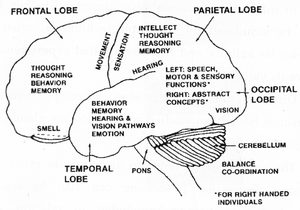
Sensation: Body position--Parietal lobes, Auditory-temporal lobes, Vision- Occipital lobes
Memory: is a diffuse process and involves deeper structures like thalamus, deeper areas of brain and all newer areas
Recognition:
Logic: (same as memory above)
Inference and verbal expression: Frontal lobes-Brocas area + other areas brain parietal lobe for language development.
Jain texts not only explains these functions of sensation, memory, logic and verbal expression, but also jives interlinkages between them. The present work depicts the precise brain areas and interlinkages between them. It also opens a way for scientific investigation of neural pathways and information processing explained in the Jain scriptures.
The exact brain pathways corresponding to the Jain model of information processing as described in Jain text has to be simulated by computer technology, must be tested for its validity and then be applied experimentally to prove its validity.
Direct cognition or Extra Sensory Perception such as clairvoyance have been studied with endocrine glands and other glandular secretions.
The sensory perception can also include expression processing. Expression processing can also be studied independently as verbal knowledge in relation with linguistics and language philosophy. The process of verbal knowledge as per Jain texts is as follows:
Verbal knowledge always occurs after perceptual knowledge as perceptual knowledge always goes before verbal knowledge[2]. Whenever something is explained by way of word or signs, its apprehensions, speculations, perceptual judgments and retentions are all there. In the case of verbal knowledge too, as in perceptual knowledge, senses and mind play a significant role. Their association is essential for gaining knowledge. The process of it is described in the Jain canon Nandi Vṛtti and developed by Acarya Mahāprajña [3] as follows:
Fig No. 9.3. Process of Verbal or Articulate Cognition
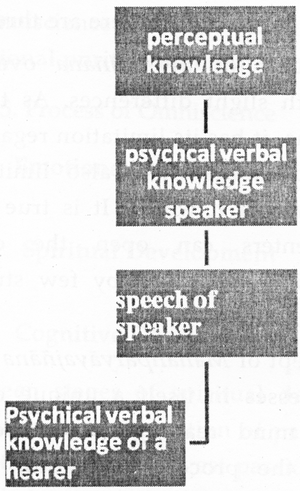
Jain philosophy has explained the phenomenon of speech or speaking very deeply. According to it, during speaking, first the speaker appropriates the clusters of speech-particles, transforms them into speech, and then releases them. In this process, in the first instant of time (tl), the speech-particles are appropriated and in the second instant of time (t2), they are released after conversion into speech. However, at the same time-instant (i.e. t2); new clusters of speech-particles are also appropriated, which are then released in the third time-instant (t3), and so on. In this way, continuously there is simultaneous release of the formerly appropriated speech-particles and appropriation of the new speech-particles, every moment.
Now, while discussing extra sensory perception, if we go according to Jain texts, there are three levels.
The concept of Avadhijñāna overlaps with the clairvoyance with slight differences. As the word avadhi means limitations, it has its limitation regarding substance, place, time and modes. It is also limited to direction and shapes in which it works. It is true that meditation on psychic centers can open the doors to Extra Sensory Perception as proved by few studies as that of Dharmesh Muni.
The concept of Mahaḥparyāyajñāna or mind reading in Jainism possesses in itself a unique explanation. The uniqueness of mind reading from other philosophical school lies in the process of reading mind. It holds that reading other's mind is not only subjectively done process but an objective mapping is also necessary. Thus the process of mind reading in Jain texts can be traced as follows:
Fig No. 9.4. Process of Mind Reading In Jainism
The thinker thinks of an object → The thinker gathers → the material aggregates → The mental substance of thinker takes the form of an object → It produces objective maps → The reader cognizes the maps or figures of mental substance of thinker → Depending on the details of mental substance, the reader infers about the object thought by the thinker.
Omniscience is closely related with spiritual evolution and spiritual evolution with the emotional purification and emotional purification is attained by the triad of destruction of relevant karmas, one's effort and environment. Omniscience is stage attained through spiritual purity and emotional purity leading to cognitive purity.
Fig No. 9.5. Process of Omniscience
Emotional Development
↓
Spiritual Development
↓
Cognitive Development
The fourteen stages of spiritual development is a journey suppression and elimination of passion, delusion and impure emotions from strongest passion to no passion state from deluded to non-deluded cognition, i.e., from impure to purest cognition called omniscience.
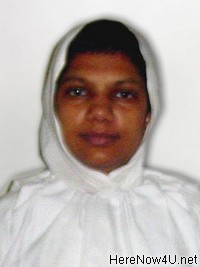 Samani Chaitya Pragya
Samani Chaitya Pragya
